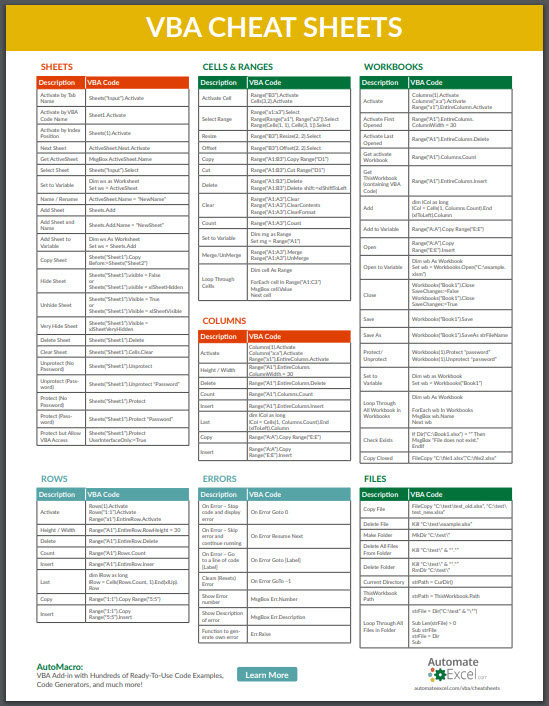3 Ways to Duplicate Sheets in Excel Macros

In today's fast-paced business environment, efficiency is key, and Microsoft Excel has long been a staple tool for enhancing productivity. One of the many features that Excel provides to streamline workflows is the ability to duplicate sheets using macros. Macros allow users to automate repetitive tasks, saving time and reducing the chance of errors. In this detailed guide, we will explore three different methods to duplicate sheets in Excel using VBA (Visual Basic for Applications) macros.
Method 1: Using the Standard Duplicate Sheet Feature

The first method we’ll look at involves the standard feature that comes with Excel:
- Open your Excel workbook.
- Select the sheet you want to duplicate by clicking on its tab.
- Right-click on the tab and choose “Move or Copy…”
- In the dialog box that appears, check the “Create a copy” box, choose the location where you want the new sheet to be placed, and click “OK”.
This method is straightforward but lacks the customization and automation that macros provide. Here’s how you can automate this with a VBA macro:
Sub DuplicateSheet()
Dim ws As Worksheet
Set ws = ThisWorkbook.Sheets(“Sheet1”)
ws.Copy After:=ws
End Sub
To use this macro:
- Press ALT + F11 to open the VBA editor.
- Insert a new module by selecting Insert > Module.
- Paste the above code into the module.
- Close the VBA editor and run the macro by pressing ALT + F8, selecting “DuplicateSheet”, and clicking “Run”.
Method 2: Customizing the Duplication Process

If you need more control over the duplication process, here’s how you can customize it:
Sub CustomDuplicateSheet()
Dim sourceSheet As Worksheet, newSheet As Worksheet
Dim newSheetName As String
Set sourceSheet = ThisWorkbook.Sheets(“Sheet1”)
newSheetName = InputBox(“Please enter the name for the new sheet:”, “New Sheet Name”)
If newSheetName = “” Then Exit Sub
sourceSheet.Copy After:=sourceSheet
Set newSheet = ThisWorkbook.Sheets(sourceSheet.Index + 1)
newSheet.Name = newSheetName
End Sub
This macro allows you to:
- Name the new sheet as desired.
- Automate the process of naming and positioning the new sheet.
To execute this macro:
- Follow the same steps as above for inserting and running the macro.
- You’ll be prompted to enter a name for the new sheet.
Method 3: Batch Duplication of Sheets

For those needing to duplicate multiple sheets at once, consider using:
Sub BatchDuplicateSheets()
Dim ws As Worksheet
Dim i As Integer
For i = 1 To 3
For Each ws In ThisWorkbook.Worksheets
ws.Copy After:=Worksheets(Worksheets.Count)
Worksheets(Worksheets.Count).Name = ws.Name & “_Copy” & i
Next ws
Next i
End Sub
This script will:
- Duplicate each sheet in the workbook.
- Add a suffix to the new sheet names for easy identification.
To run this macro:
- Insert the code into a new module as explained earlier.
- Run the macro to duplicate all sheets in the workbook three times each.
✅ Note: Remember to save your workbook as a Macro-Enabled Workbook (`.xlsm`) to retain your macros and to enable the macros when opening the workbook.
Each method has its place in streamlining your work with Excel. The standard feature is great for one-off tasks, while the custom and batch duplication macros cater to more complex or repetitive workflows. By incorporating these macros into your Excel toolkit, you'll not only increase efficiency but also reduce manual errors that can occur during data management tasks.
Can I duplicate sheets between different workbooks using macros?

+
Yes, you can use VBA to copy sheets between different workbooks. For instance, you can reference another workbook using its name or path in the Workbooks collection within the code.
What are some common errors when using Excel macros?

+
Common errors include attempting to rename a sheet to a name that already exists, using a reserved word like ‘Sheet1’, or not having the necessary workbook or sheet references properly set.
How can I further customize the macro to fit my specific needs?

+
Customization can range from altering the naming conventions, setting specific locations for the duplicated sheets, to integrating conditional formatting or data validation based on certain criteria. You can explore additional VBA capabilities like loops, conditional statements, and Excel object manipulation.



